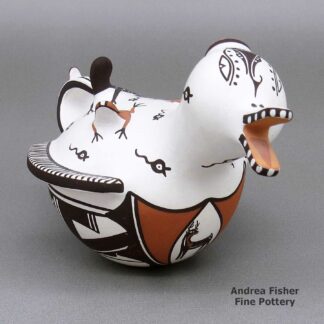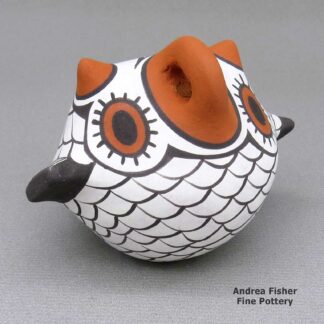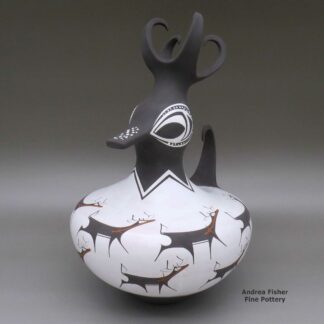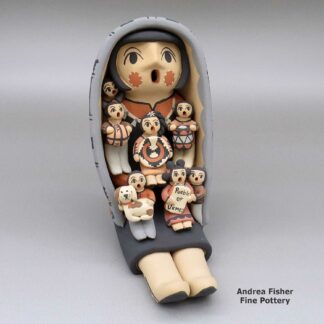Figure
About Figures and Figurines
Generally, "Figure" denotes a real or mythic creature, like an owl or human or katsina or Corn Maiden. Whether form or decoration, all Puebloan pottery figures are meant to invoke particular spiritual essences. That's why "effigy" is used almost as often as "figure" to denote these pieces.
Among most Puebloans, the figure of an owl, for example, signifies all the physical and spiritual aspects attributed to the owl. It's a form of prayer to the spirit of "Owl" and the appropriately decorated physical form is meant to make that spirit manifest. However, to the Zuni people an owl is a good omen and to the Tewa people, an owl is a bad omen. Some potters at Santa Clara have made owls anyway, they just shaped and decorated them to reflect that "badness."
That explanation may make more sense in the case of the Corn Maiden as she is a mythic entity whose existence revolves around the most ubiquitous food staple in the Puebloan world: corn (maize). All representations of the Corn Maiden are meant to invoke her benevolence and abundance for their people. Because of her mythical/spiritual nature, different pueblos have slightly different physical forms for her but they all incorporate the basic form of a female human face on an ear of corn.
The potters of Tesuque turned out thousands of muna figures (also known as rain gods)for several decades, until they virutally burned out their pottery tradition. These muna had very specific shapes but were decorated with everything from micaceous slips to incised lines to polychrome geometric designs to poster paints. They were also made purely for domestic American consumption, sometimes delivered by the barrel to be used as prizes and giveaways.
The Storyteller is another figure based on Puebloan tradition: a tribal elder singing the stories of the tribe's oral history to the children. The original was based on the traditional cultural story: a grandfather singing his part of the story in his native language so the children learn both the language and their identity against the backdrop of that history. Shortly, the storyteller form was duplicated in several other pueblos, each pueblo's potters adapting the form to their local situation. In some places, the grandmother became the primary sex of their storytellers. At Jemez, that responsibility was shared between grandmothers and grandfathers. Then some potters in search of new niches in the marketplace branched into making "spirit figure" storytellers, like eagles, ravens, hummingbirds, cats and dogs. Some Zuni potters have made storyteller owls.
Similar to the Storyteller is the Story Time: a set of separate children displayed around a larger central singing figure.
The Nativity set (also known as nacimiento) is a set of figures based on the intersection of Puebloan mythologies and stories they heard from Christian missionaries. Those potters who make them also tend to favor dress, shapes and designs that reflect their own heritage(s). The first few nativities made at Tesuque Pueblo were decorated with Spanish colonial costumes but that soon changed and every nativity made since has a distinct blend of Native American and Christian, with no other reference to colonialism. The "Singing Angel" (a single standing figure with outstretched wings and hands clasped together in prayer) and "Flight to Egypt" (usually depicting Mary with a baby Jesus on the back of a donkey and a standing Joseph nearby holding the rein) are similar mixes of tribal and Christian figures. The miniature nativities made by Santa Clara/Dineh artist Linda Askan clearly show Dineh religious influence in the headresses worn by Joseph, the angel and the three wise men. At the same time, the Dineh Folk Art nativities made by Jonathan Chee are based on the realities of daily Dineh life: the three wise men wear wide-brim hats and blue jeans, and bring gifts of salt and 50-pound bags of flour.
Pueblo and Dineh artists also make a full zoo of domesticated, farm and wild animal figures: horses, donkeys, cows, chickens, pigs, sheep, turkeys, giraffes, elephants, dogs, cats, mermaids, women-dressed-up-and-taking-selfies and cowboys among them.
Showing 1–12 of 84 results
-

Aggie Henderson, jhac3b021, Storyteller with five children
$175.00 Add to cart -

Agnes Peynetsa, zzzu3b515, Duck pot with a deer with heart line design
$395.00 Add to cart -

Anderson Jamie Peynetsa, zzzu3b072m1, Small polychrome owl figure
$165.00 Add to cart -

Anderson Jamie Peynetsa, zzzu3b072m2, Small polychrome owl figure
$165.00 Add to cart -

Anderson Jamie Peynetsa, zzzu3c030m2, Polychrome owl figure
$850.00 Add to cart -

Anderson Peynetsa, zzzu3c240, Duck pot with geometric design
$1,900.00 Add to cart -

Angela Corona, zzcg3b113, Owl effigy with an owl, branch and geometric design
$125.00 Add to cart -

Angela Corona, zzcg3b114, Owl effigy with an owl, branch and geometric design
$290.00 Add to cart -

Anita Suazo, sssc3a190, Turtle figure carved with a geometric design
$395.00 Add to cart -

Chrislyn Fragua, zzje3a170m1, Polychrome reclining storyteller with three children
$325.00 Add to cart -

Chrislyn Fragua, zzje3a170m2, Polychrome storyteller with four children
$325.00 Add to cart -

Chrislyn Fragua, zzje3a171, Polychrome storyteller with seven children
$650.00 Add to cart
Showing 1–12 of 84 results